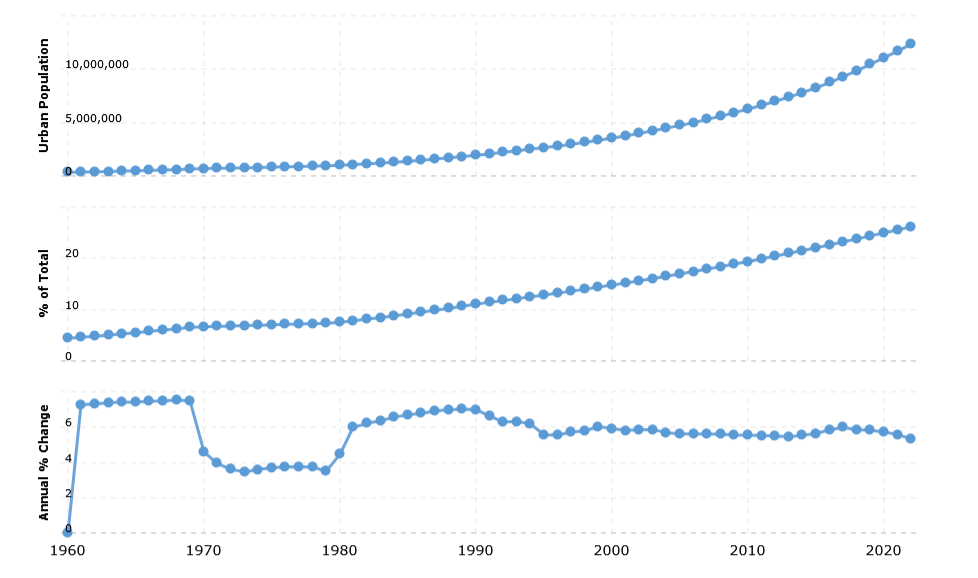
Urban Statistics according to 2020

Uganda, like many rapidly developing countries, faces significant urban challenges. With the increasing urban population, cities like Kampala,Gulu are grappling with issues that hinder sustainable development and quality of life. This blog delves into the key urban issues in Uganda, highlighting overpopulation, inadequate infrastructure, environmental concerns, and proposing potential solutions for these pressing problems.
Introduction
Uganda’s urbanization is both a sign of progress and a source of concern. As more people movie to cities seeking better opportunities, the existing urban infrastructure is stretched thin, leading to issues. From overcrowded slums to congested roads, the urban challenges in Uganda are numerous and complex. This article aims to shed light on these problems and explore viable solutions to foster sustainable urban development.
Overpopulation and Housing Crisis

One of the most pressing issues in Uganda’s urban areas is overpopulation. With a high population growth rate, urban centers are expanding rapidly, often without proper planning. This results in overcrowded living conditions, particularly in informal settlements and slums.
- Slum Proliferation: Slums like Katanga in Kampala are home to thousands of people living in deplorable conditions. These areas lack basic amenities such as clean water, sanitation, and electricity, leading to health risks and reduced quality of life.
- Inadequate Housing: The demand for affordable housing far exceeds supply, causing many to live in substandard conditions. The housing deficit is exacerbated by the rising cost of land and construction materials.
Potential Solutions:
- Affordable Housing Projects: The government and private sector should collaborate to develop affordable housing projects that cater to low-income populations.
- Urban Planning: Implementing effective urban planning policies can help manage population growth and ensure sustainable development of new residential areas.
Inadequate Infrastructure
The rapid urbanization in Uganda has outpaced the development of necessary infrastructure. This inadequacy affects various sectors, including transportation, healthcare, and education.
- Transport System: Kampala’s transport system is notorious for its traffic congestion. The roads are often overcrowded with vehicles, causing delays and increasing pollution levels.
- Healthcare and Education: Many urban areas lack sufficient healthcare facilities and schools to cater to the growing population. This results in overcrowded hospitals and classrooms, affecting the quality of services provided.
Potential Solutions:
- Public Transport Improvements: Developing a reliable and efficient public transport system, such as buses and light rail, can alleviate traffic congestion and reduce pollution.
- Investment in Social Infrastructure: Increased investment in healthcare and education infrastructure is essential to meet the needs of the urban population. This includes building more hospitals, clinics, and schools in urban centers.
Environmental Concerns

Urbanization in Uganda has led to significant environmental challenges, including pollution, waste management issues, and deforestation.
- Pollution: Industrial activities and vehicle emissions contribute to air and water pollution in urban areas. Poor waste management practices exacerbate this problem, with many areas lacking proper waste disposal systems.
- Deforestation: The expansion of urban areas often involves clearing forests, leading to habitat loss and decreased biodiversity.
Potential Solutions:
- Sustainable Practices: Promoting sustainable industrial practices and encouraging the use of cleaner technologies can help reduce pollution levels.
- Waste Management Systems: Implementing efficient waste management systems, including recycling and proper disposal, is crucial for maintaining a clean urban environment.
- Urban Green Spaces: Creating and maintaining green spaces within cities can help mitigate the effects of deforestation and provide residents with areas for recreation and relaxation.
Limited Access to Essential Services
Access to essential services such as clean water, sanitation, and electricity remains a significant challenge in Uganda’s urban areas.
- Water and Sanitation: Many urban residents lack access to clean water and adequate sanitation facilities. This leads to health issues such as waterborne diseases.
- Electricity: Frequent power outages and limited access to electricity hinder economic activities and affect the quality of life.
Potential Solutions:
- Infrastructure Development: Investing in the development of water supply and sanitation infrastructure is crucial to ensure access to these essential services.
- Renewable Energy: Promoting the use of renewable energy sources, such as solar power, can help improve electricity access and reduce dependency on the national grid.
Conclusion
Urbanization in Uganda presents both opportunities and challenges. While the growth of urban areas can drive economic development, it also brings about significant issues that need to be addressed urgently. By focusing on sustainable development, improving infrastructure, and ensuring access to essential services, Uganda can create urban environments that offer a higher quality of life for all residents.
Addressing these urban challenges requires a collaborative effort from the government, private sector, and communities. With the right strategies and investments, Uganda can transform its urban centers into thriving, sustainable cities that meet the needs of its growing population.
FAQs
- What are the main urban challenges in Uganda?
- The main urban challenges include overpopulation, inadequate infrastructure, environmental degradation, and limited access to essential services.
- How can Uganda address its housing crisis?
- Uganda can address its housing crisis by developing affordable housing projects and implementing effective urban planning policies.
- What solutions are there for traffic congestion in Kampala?
- Solutions include developing a reliable public transport system, such as buses and light rail, to alleviate traffic congestion.
- How can environmental issues in urban areas be mitigated?
- Environmental issues can be mitigated by promoting sustainable practices, implementing efficient waste management systems, and creating urban green spaces.
- What steps can be taken to improve access to essential services?
- Steps include investing in water supply and sanitation infrastructure, and promoting the use of renewable energy sources.

